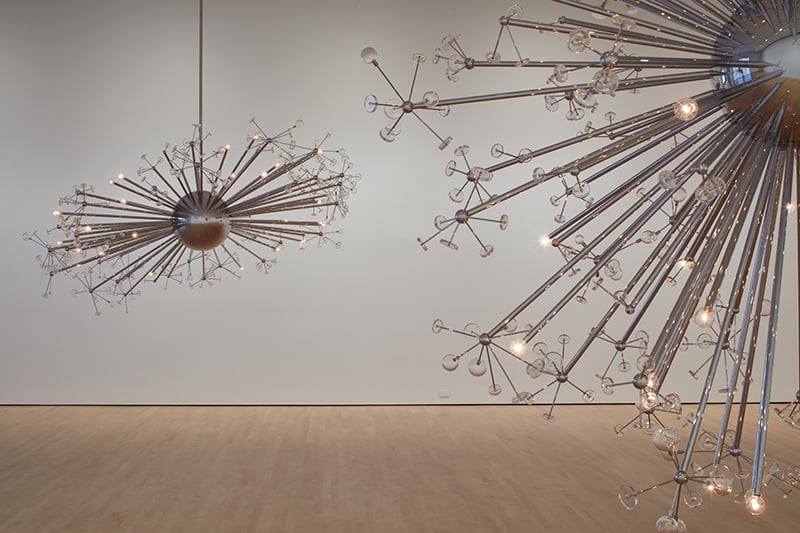Walking into Josiah McElheny’s “Island Universe” exhibition felt different, even though the indoor space was nothing out of the ordinary — a large cuboid room with modern cement walls and ceiling, with wooden floors. Erratically hung from the ceiling are chandelier-like, shiny steel and glass figures. As I walked through the room, the figures gave an impression of movement and expansion. But I didn’t understood what was moving and expanding until I recalled the name of the exhibition: “Island Universe.”
“Island Universe” represents possible models of the early universe through sculpture. The temporary exhibition is open at the Cantor Arts Center from Feb. 23 to Aug. 18, 2019.
“I have been very moved by the way that so much of the grand ideas around cosmology come from a source that’s very, very simple,” McElheny said in a video interview with Cantor Arts Center director Susan Dackerman.
McElheny is a New York-based artist and sculptor whose main works include recreations of Renaissance glass objects and abstract contemporary sculptures. He worked closely with David Weinberg, an astrology professor at Ohio State University, to help develop scientifically accurate measurements for “Island Universe.”
Collaboration between artists and scientists is not unusual at Stanford. Former Stanford postdoctoral fellow Thomas Juffmann worked with UC Berkeley’s Phillip Haslinger and the San Francisco Art Institute’s Enar de Dios Rodríguez on SEEC, an abbreviation for “see light.” SEE Photography relies on highly advanced cameras to help people see what happens at the speed of light — how light is scattered and reflected as it travels.
Stanford also offers a variety of different Art + Science programs through both The Senior Reflection, a series of courses for Stanford seniors interested in art and science, and the Cantor Arts Center Art + Science Learning Lab, a behind-the-scenes learning experience of science and the conservation of arts.
“Island Universe” consists of “five different propositions and possible models for the emergence of the universe,” Dackerman said. Through these models, McElheny harmonizes art and astrophysics by making complex scientific theories visualizable without losing scientific precision.
In each of the five figures, a big central sphere represents the origin of the universe, while light bulbs and little glass circles on the inside represent the present time. When viewed from afar, the figures sparked my imagination surrounding expansion of the universe. And as I looked closer at each of figures, I experienced the profound feeling that I was traveling back through time.
The five chandeliers in McElheny’s exhibition are each made of parts manufactured in different locations, but assembled at the Cantor Arts Center. They contain rods and spheres made of chrome-plated aluminum and riggings, hand blown and molded lights and other glass parts and electric lighting and rigging, according to the description in the exhibition.
“The most complicated parts of the whole project are these little one inch spheres,” McElheny said. “They cost $1000 each to make.” These metal spheres were made in Queens, New York, and then shipped to Los Angeles, where holes used to install rods that connect to the glass parts were punctured using $2 million machines called 5-axis lathes.
“Island Universe” is inspired by the Metropolitan Opera’s chandeliers and the Inflationary Universe Theory, which is an explanation for the expansion of the early universe developed by Stanford physics professor Andrei Linde.
Inflation, the exponentially fast expansion of the universe, is capable of producing not just a universe which appears identical everywhere, but a multiverse consisting of many different exponentially large universes, each with its unique properties, Linde said.
“[McElheny] was trying to use art to represent something that we cannot see with our eyes,” said Linde, who has visited the exhibition and gave a presentation about it at the Cantor Arts Center. “He was not showing something in space, but in each part of the multiverse evolving in time.”
McElheny wanted his models to appeal to people from different backgrounds. As a result, the arrangements and proportions of every component of the models are carefully considered, purposeful and precisely follow their scientific derivations, even if they are modeled on speculative and theoretical science. The sculptures aim to simultaneously engage artists and philosophers — who might view the work from a bigger-picture point of view — and scientists, who might emphasize the details.
“Cantor serves as an inclusive gathering place to connect people through the presentation of diverse art and ideas, which is what happens when one experiences ‘Island Universe,’” Dackerman told the Daily. “Having such works at Stanford affords the opportunity to bring the community together with students and faculty from every discipline to think about how seemingly disparate ideas interrelate in our lives.”
Contact Brian Lee at bl45983 ‘at’ pausd.us.
